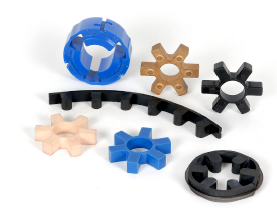Elastomers In Compression
We presents four kinds of elastomer patterns to allow for extra flexibility in addressing distinct application demands. A single piece patterns are used in the “L” and “AL” models (referred to as spiders) and various element “load cushions” are utilized  in the “C” and “H” model couplings. The load cushions are in sets of six to 14 pieces according to coupling dimension.
in the “C” and “H” model couplings. The load cushions are in sets of six to 14 pieces according to coupling dimension.
Reliable Center Spider
The solid center design and style is normally employed style when shafts with the driver and driven equipment can be stored separate by a regular gap
Open Center Spider
The open center layout permits for your shafts of your driver and driven to become positioned inside of a brief distance
Open center spiders give shaft positioning versatility but have a reduced RPM capacity
Cushions
Used solely for the C and H Variety couplings
Load cushions are held in area radially by a steel collar that is connected to one of the hubs
Snap Wrap Versatile Spider
Design and style allows for easy elimination of the spider with out moving the hubs
Permits for close shaft separation every one of the way as much as the hubs greatest bore
Greatest RPM is 1,750 RPM using the retaining ring, but when applied using the LC Variety (with collar) the standard RPM rating of your coupling applies
Type is available in NBR and Urethane only, and in constrained sizes
Spider Supplies
SOX (NBR) Rubber
The common material that’s remarkably versatile material that is definitely oil resistant
Resembles purely natural rubber in resilience and elasticity, and operates successfully in temperature ranges of -40° to 212° F (-40° to 100° C)
Urethane
Has 1.five times higher torque capability than NBR
Good resistance to oil and chemicals
Material presents much less dampening result and operates at a temperature array of -30° to 160° F
Hytrel
Versatile elastomer developed for substantial torque and substantial temperature operations
Operates in temperatures of -60° to 250° F (-51° to 121° C)
Bronze
Rigid, porous, oil-impregnated metal insert solely for reduced velocity (max 250 RPM) applications requiring higher torque capabilities
Not affected by water, oil, grime, or intense temperatures – operates in temperatures of -40° to 450° F (-40° to 232° C)
